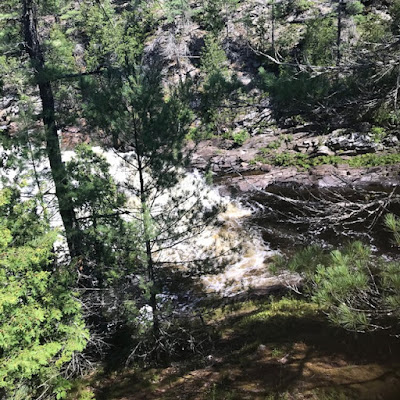With COVID-19 still being an issue around the world, our "travel" for 2020 remains inside our province of Ontario. Thankfully, Ontario is huge, beautiful and there is plenty to explore. For our major summer vacation we rented a wonderful little AirBnB cabin on Manitoulin Island where the best of everything to do is outside anyway.
On our first full day on the island, since it was still the long weekend, we decided to travel one of the less popular hikes I'd researched. Misery Bay Provincial Park is the only operational, day use only, provincial park on the island.
 |
| Molly hiking on The Canadian Shield |
Although I'd planned to tackle the 8KM Costal Alvar hike I found online, later research on
Alltrails.com revealed that portions of this hike were under water because of high water levels in and around Lake Huron. Instead we completed the 5KM Inland Alvar Trail.
Since we were there on the holiday Monday, there was no one at the visitor centre. We paid our admission via a machine ($2 each for the adults, $1 each for the kids for a reasonable price of $6 total).
So much of this hike is directly on the Canadian Shield, an ancient Alvar rock that acted like a path.
I'd only ever seen this type of plant life, sometimes called Reindeer Lichen, (frequently eaten by deer and contestants on the Survivalists History Channel show ALONE) on TV so I had to snap a picture of it. We didn't try eating it.
One of the many cool things about this hike was how solitary it was. We truly felt like we were alone in the wilderness and the chances of us seeing some wildlife was high. We only ran into two other hikers during our entire hike, and then another two families when we returned to our car. The wildlife we saw was mostly birds and squirrels. When we arrived at the park we saw two giant hawks perched on the Park sign that we thought were statues, until they flew away.
The wild flowers on the island are so bright and vibrant I just had to snap some photos.
At various rock "clearings" we passed throughout our hike. We were able to see rock art that other hikers had created.
These are some of our favourites. People made pictures, wrote out names, and in some cases indicated the date and year, some clearly untouched from over a year ago.
This is the beach portion of the trail that overlooks Misery Bay, however the water you see here is also a part of the longer hike that we skipped because it was flooded.
This bright yellow flower is called Manitoulin Gold and is virtually everywhere, lining highways and hiking trails alike.
Another Rock clearing we found was filled with dozens of Inukshuks people had made.
Molly thought this rock art looked like Cookie Monster. Do you see it?
Molly celebrating the end of our adventure at Misery Bay by climbing on top of a giant rock. We all highly recommend this 5KM easy hike. For all hikes on Manitoulin Island I'd suggest wearing long pants because there is a lot of Poison Ivy. We had a cool day that threatened rain the day we explored, which was perfect for long pants and a sweat shirt. Chris and I loved the raw ruggedness of this hike and the feeling like we were the only people in the world, while Molly and Jack adored seeing what rock art created by other hikers was around each corner. Definitely a must do on the island!
It took us about two hours to complete this hike, including several stops for snacks, photos, and exploring the rock art.
To us there was nothing Miserable about Misery Bay, however according to the Website
Friends of Misery Bay this is how it got the name: According to local lore, the earliest settlers—lacking hay
came to the foot of the bay to cut marsh grass for their livestock.
One warm June day in the early 1880’s, a pioneer was cutting marsh grass there when two men approached in a small boat. The boaters shouted, “What is this place called?” Hot, tired, and swatting black flies, the farmer called back, “I'm in misery!”
What the farmer did not realize was that the boaters were government surveyors, mapping the island. The surveyors wrote that name down, and it stuck. So this beautiful spot with its clear water, unique rocks, bountiful wildlife, and lovely wildflowers continues to be known as Misery Bay—a misnomer puzzling to today’s visitors.













































